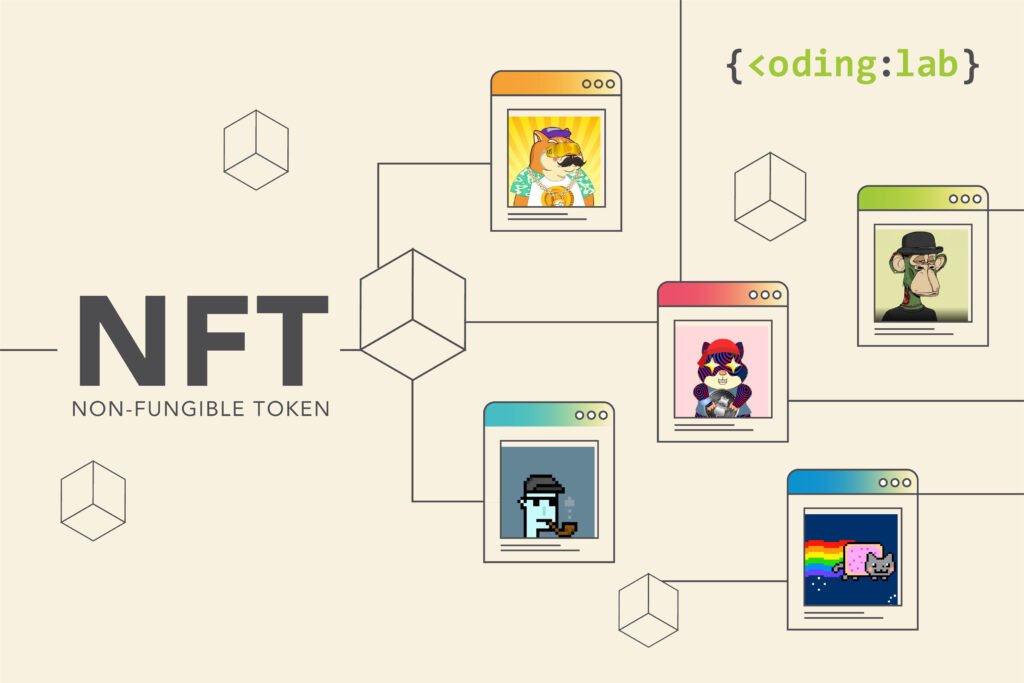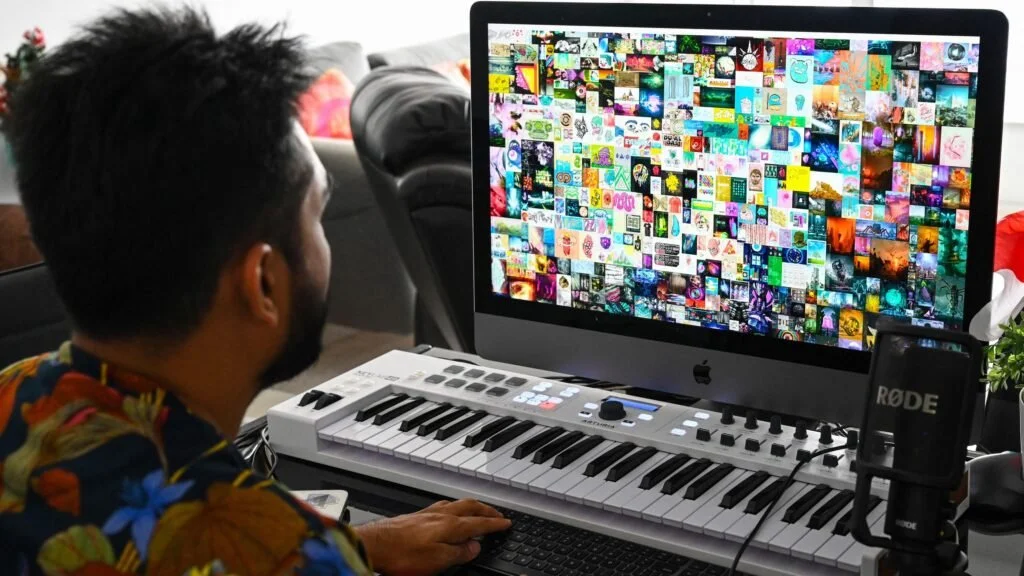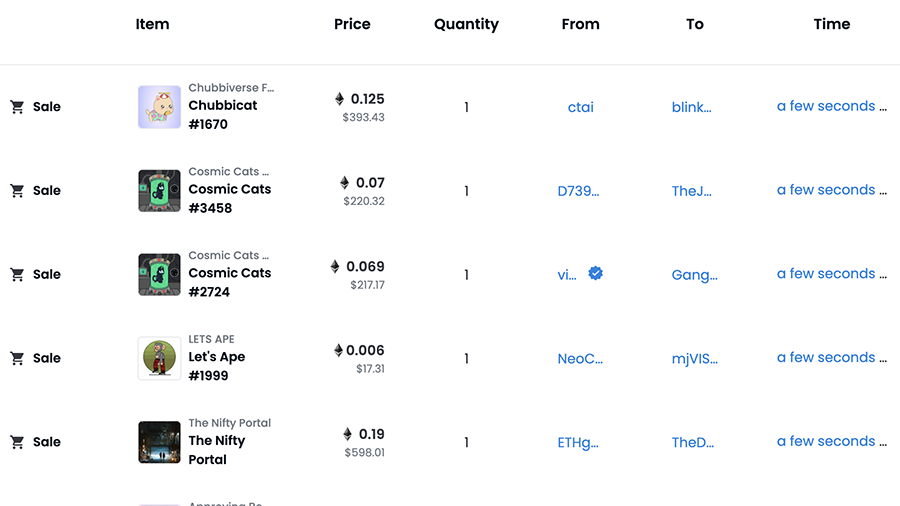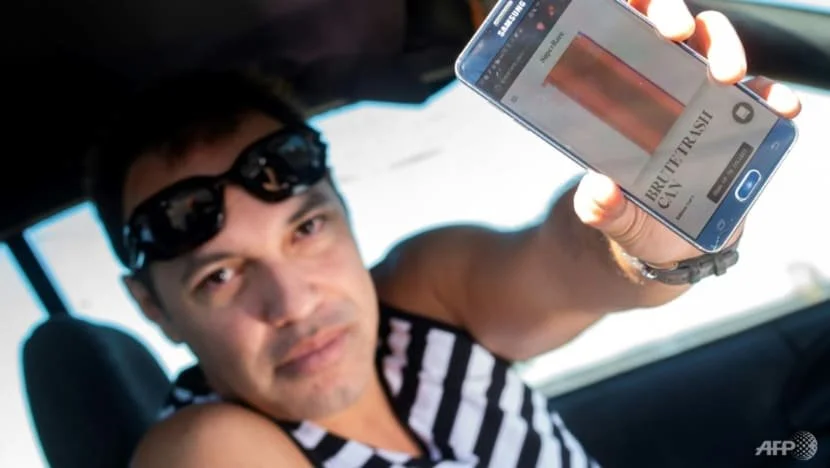All About NFTs, Simplified
NFTs are all the rage these days. From artists like Jay Chou to musicians, influencers, that monkey/ape profile picture, and your friend posting about the NFT they just bought, everyone seems to be jumping on this bandwagon. 🤔 So what are NFTs, how do they work, and what is the hype all about? Are you up to date? The Coding Lab Team has it all simplified for you here! 👇
What are NFTs?
NFT stands for 'Non-Fungible Token'.
Non-Fungible means that the item is unique and cannot be swapped or replaced with something else. It's exclusive. Token refers to it being digital and protected using blockchain technology.
Putting it together, a Non-Fungible Token is a one-of-a-kind asset. Think of it as owning the only Picasso painting, or one of the rare Pokémon trading cards, or an autographed poster - there is only one original copy of it, and it's irreplaceable. Purchasing an NFT represents your ownership of the items.
NFTs are a type of cryptocurrency.
Most NFTs today are part of the Ethereum (ETH) cryptocurrency, which runs on blockchain technology. However, it is not only Ethereum, you can sell an NFT and ask for whatever currency you want.
We get it, more tech buzzwords that are making your head spin! Don't worry, let's break it down:
What is cryptocurrency?
Cyptocurrency
Cryptocurrencies (or cryptos) are digital currencies, based on blockchain technology, with no central authority. This means that instead of banks or the Monetary Authority of Singapore, internet users manage and maintain its value through several computers. The most well-known cryptos include Ethereum and Bitcoin. Similar to money, you can use crypto to buy things or purchase crypto as an investment. Crypto is fungible because 1 ETH / $1 USD is exchangeable for another 1 ETH / $1 USD.
What is blockchain technology?
Blockchain technology
This refers to shared, decentralised financial records of digital assets that cannot be modified. With each transaction, a "block" of data is recorded across several computers in a peer-to-peer network. These blocks are linked - or chained - together to prevent any changes in the blockchain.
Simplified: NFTs are a type of digital currency. Instead of holding money, they hold unique assets like art or music. Instead of banks and other central authorities protecting it, blockchain technology secures it.
"The whole point of using a blockchain is to let people – in particular, people who don’t trust one another – share valuable data in a secure, tamperproof way."
– Mike Orcutt, MIT Technology Review
How do NFTs work?
NFTs are digital certificates of authenticity with a unique identifier (think: similar to a barcode or ID number), with the sale recorded and secured by the Ethereum blockchain. This record is shared to the public (maintained by thousands of computers around the world) - there are no banks or central authority involved - so anyone can verify it and it can't be modified or copied. When an NFT is transferred from seller to buyer on a public marketplace, that proof-of-ownership is transferred.
NFTs of this Indonesian student's selfies bagged him more than US$1 million. (Screenshot taken from NFT marketplace)
This means tokenising things like photos, art, GIFs, videos, music, animated stickers, programming code, and so much more, which can only have one official owner at a time. This also means creating scarcity of assets (it is up to the owner and available information for the public), which may drive prices up or down.
Confused? Imagine you are going to buy or sell NFTs. You'll go to an NFT marketplace with your digital wallet, which is NFT-compatible. There are digital photos, art, music, and much more for sale. After browsing, you decide to buy an NFT. The Ethereum blockchain records this sale and publishes it online, ensuring security in your transaction. You get your digital product (which sometimes comes with real-life items) and a unique identifier that certifies that you are the owner of the authentic item.
What constitutes an NFT?
From fine art like Picasso's paintings being released as NFTs to the photo of the rubbish bin sold for US$252,000, almost anything can be minted (published) and sold as NFTs, and there is now a mainstream interest in digital collectibles.
I’m selling this song about NFTs as an NFT pic.twitter.com/B4EZLlesPx
— Elon Musk (@elonmusk) March 15, 2021
Elon Musk released a song about NFTs to sell as an NFT, which he later changed his mind about.
Recently, Christie's auction house sold this Beeple JPG file for US$69.3 million (to a Singapore-based technopreneur), a new record for digital-only art. Even real estate - virtual real estate - in the Metaverse, in the online world Decentraland, was sold in the form of NFTs for US$2.4 million (S$3.3 million).
More about international NFT headlines 👇
Sales of NFTs hit US$25 billion in 2021, compared to the US$94.9 million in 2020.
The CEO of Twitter, Jack Dorsey, sold his first tweet NFT for US$2.9 million.
In the fashion world, brands like Givenchy, Burberry and Adidas have announced NFT collections and digital wearables, while other fashion brands like Louis Vuitton and JW Anderson are taking different approaches into NFTs. Decentraland will be hosting the first Metaverse Fashion Week (MVFW) in March this year. You can attend the event for free and choose to purchase digital wearables with Ethereum, with opportunities to buy physical real-life designs.
In the sports world, people have spent more than US$230 million on digital collectibles of NBA highlight videos. This blockchain-based card system known as NBA Top Shot includes a highlight video of LeBron James scoring for a record US$208,000.
Did you know that musicians like Kings of Leon and Snoop Dogg are releasing their new albums in the form of an NFT?
More NFT news in Asia 👇
You might have seen Jay Chou posting about PhantaBear, which has topped the Global NFT Sales with a total value of US$53 million. Buyers of PhantaBear NFTs are promised the art, ticket access to virtual concerts and special access to premium venues.
Have you heard of the Indonesian student's seflies that are worth more than US$1 million?
Malaysian artist Red Hong Yi created the Memebank Banknotes NFT series of spoofed and redesigned banknotes, with Doge To The Moon sold for about US$78,000. An exhibition for Memebank is also in the works.
A physical NFT art gallery opened in Bali in January 2022.
K-pop companies are jumping on NFTs too, such as NFTs of BTS photocards and NFTs for other groups that come with perks such as concert tickets and autograph signings.
More about NFTs closer to home, in Singapore 👇
The Straits Times auctioned its column and 3 of its art illustrations as NFTs, earning more than S$21,000 for charity. It included this infographic on a guide to cryptocurrencies, which sold for S$3,388.
Local musician Hanjin Tan auctioned his single, Nobody Gets Me, for about US$17,000 in April 2021.
Actor Andie Chen’s blockchain gaming company, Freedom Nation, is valued at S$12 million and loans NFTs in online games.
JJ Lin owns a Bored Ape Yacht Club NFT, a CryptoPunk NFT and 3 plots of virtual land, which is worth a total of about US$820,000.
More Singapore creators are riding the NFT wave, such as Tasty Toastys NFT collection, Dark Zodiac NFT digital trading cards, and artist Speak Cryptic.
Still with us? That last Instagram story you took, the photo of the view outside your window, your phone-recorded rendition of Beethoven’s Symphony No. 5 in C minor played on your keyboard – really anything digital can be minted and sold as NFTs.
After reading all these headlines about buying and selling NFTs, it's easy to be reeled in. But remember that these are just the success stories and celebrities who are jumping on. Every decision comes with benefits and risks!
What benefits are there?
Singapore-based technopreneur Metakovan showing his record-breaking US$69.3 million NFT of "Everydays: The First 5,000 Days", a digital collage by Beeple. (Photo credit: AFP via Getty Images)
The hype today revolves around buying and selling digital art on NFT marketplaces.
But what's so special about digital files that you can just right-click and save? Just like how anyone can buy a Picasso print, only one person can own the original. Only those few can own that luxury bag or that surprise sneaker drop. In NFTs, it's the blockchain-certified ownership of the original work (and bragging rights).
For artists, creators or sellers:
Artists get a cut of the sales every time their NFT changes hands. They get to make their own terms with 'smart contracts' on the blockchain, through a process known as minting NFTs.
Digital work can be sold more easily by trading directly online in NFT marketplaces and with access to a larger audience. A big investor, collector or celebrity might purchase your art, opening the door for you and your work.
Transparency. With all the transactions recorded on the blockchain, prices of the last sale and who the NFT belongs to are visible to everyone. This way, artists know who (the username) and where their NFTs are.
For buyers or collectors:
Anyone can purchase NFTs, unlike traditional art auctions where buyers are vetted.
Buying NFTs financially supports the creators of the work, and grants ownership and usage rights (but not the copyright).
NFTs as an investment. Just as with other assets, you can buy NFTs with the hope of its value appreciating in the future, so that you can sell it for a profit.
Some NFTs come with perks, such as real-world items, access to digital or in-person events, and free NFTs.
This screenshot shows the information (such as the price in ETH and usernames of the buyer and seller) made public when you buy or sell on an NFT marketplace.
Remember that not all NFTs are like that one original Picasso piece. It could also be the Pokémon trading card with 5 copies, or even 50. Some people see NFTs like fine art collecting, while others treat it like collecting Pokémon cards.
"Artists have been using hardware and software to create artwork and distribute it on the internet for the last 20 plus years but there was never a real way to truly own and collect it. I believe we are witnessing the beginning of the next chapter in art history, digital art."
- Beeple, whose real name is Mike Winkelmann, NPR
What are the issues?
"I can't even remember where the image came from, I think it was a Google image search," says American artist Robness, who sold his NFT for US$252,000. (Photo credit: AFP/Valerie Macon)
1. Scammers are everywhere, and that includes NFTs.
As much as NFTs are now a new way for creators to earn money, it opens up new avenues for art theft as well. Several artists have their work turned into NFTs without their consent or any attribution, some even through impersonating the artists themselves. Copying and stealing work is easy with a few clicks, and minting NFTs is an anonymous process that allows art theft to go unnoticed. It happens in the real-world with fakes and plagiarism, it goes on in the digital world as well.
You might be wondering, "Isn't blockchain technology safer?" Well, cryptocurrencies are based on blockchain technology, and have been stolen before.
With anonymity and lack of verification, it's hard to know what you're buying and who you're buying from. For example, the Evolved Apes NFT project promised "a collection of 10,000 unique NFTs trapped inside a lawless land". With US$2.7 million, the developer disappeared and buyers never got a thing. This isn't the first time that something like this happened.
2. There are concerns about the environmental impact of NFTs.
When blockchain technology runs on computers across the world, it's no surprise that it is energy-intensive. Similar to cryptocurrencies, it uses a lot of electricity and emits greenhouse gases, which contributes to climate change. When minting an NFT, it requires you to verify your transactions to create new blocks on the blockchain. This is done through mining, where you have to solve challenging mathematical problems and requires powerful computers.
For measure, each NFT transaction on the Ethereum network takes up about two American households' worth of daily energy. That's a lot. This is also why you sometimes have to pay "gas" fees when you make a transaction. It's also why some people are boycotting NFTs. There are some greener alternative NFT platforms and using renewable energy, though the environmental impact is still a huge concern.
3. Legal questions surround NFTs.
The artist or creator still retains the original work after the sale, and can continue sharing and selling it. As an NFT buyer, you own a unique identifier of a work of art, not the copyright to the art. After all, these are still digital files that you can copy and paste, and artists can create scarcity of their own assets when they choose to sell 1 copy of it, maybe 5, or even 50 of it.
Smart contracts are often embedded into NFTs, so it's important that you know the terms of your sale and purchase. Aside from protecting the creator's rights to royalties, it may also have conditions that limit you from transferring your NFT. (Yes, smart contracts on blockchains is a thing.)
Keep in mind that NFTs are still a relatively new asset class, so the legality and regulations around it are still under development across the world, and very much of it falls in the grey area.
In Singapore:
NFTs are not regulated by the Monetary Authority of Singapore and are not considered legal tender.
Smart contracts may or may not be legally enforceable in Singapore.
Did you know?
Cryptocurrency is beginning to be accepted as a method of payment. Bitcoin is now welcomed on websites like Microsoft, Expedia, in countries like El Salvador, and institutional adoption by the European Investment Bank. Such decentralised finance (also known as DeFi) is said to be the next big thing in fintech.
You're not missing out.
Just because you see it in countless news articles, on so many celebrities' profile pictures, and your friends posting about it, it doesn't mean that you're missing out on the latest investment. NFT markets are volatile, especially for something so new with no proven track record. There are NFTs that have fallen in value, even those minted by celebrities.
"With all these new platforms, for every individual, the caveat is you really need to know what you’re doing. If you’re not comfortable with it, don’t get near it. As you can see from cryptocurrency like Bitcoin, it is very volatile."
– Speaker of Parliament Tan Chuan-Jin, who sold a few NFTs of his landscape photographs for charity, CNA
Should you get involved in NFTs?
The world of NFTs is complex, with CryptoPunks and Bored Ape Yacht Club (yes, the ape/monkeys NFT profile pictures) constantly coming up on top.
NFTs are definitely on the rise, and can be a great opportunity for you whether you're a creator, seller, collector or buyer. You may be having these questions: Where do I start buying? How do I start selling?
Don't just jump on the hype train. Whether you're a seller or buyer, do your due diligence to find out more about reputable NFT marketplaces, secure cryptocurrency wallets and how to keep your money safe. Heard of OpenSea or Polygon? Don't share your seed phrase? Do you know the additional transaction or "gas" fees? NFTs are complicated and ever-changing. There is so much more to NFTs than what is written here!
If you're investing, remember that the market is unpredictable. Carefully consider the risks and benefits, read the smart contracts and find reputable NFT marketplaces and sellers.
If you're collecting, then just like physical art, its value is subjective and lies in the eye of the beholder. You'll be supporting the artist along the way too.
If you're selling, it could open the door for you and your work if you know your smart contracts and learn how to collect your money safely.
"The truth is that the value of any NFT is speculative. Its value is determined by what someone else is willing to pay for it and nothing else."
– Dragan Boscovic, Research Professor of Computing, Informatics and Decision Systems Engineering, Arizona State University, The Conversation
You may be wondering if NFTs have a future.
And if so, what's in store? Should you invest now? Or is this another bubble waiting to burst?
We don't have the answers either. We might just stick to right-clicking to save our photos or we could be busy minting our next NFT with our lines of programming codes (just like this 12-year-old coder did as the developer and web app creator of an NFT collection that is raking in millions).
This might be the next big thing or a hype that will die down once the next thing comes out. Just like Bitcoin was once seen as the digital currency, NFTs are now the digital collectibles. Maybe the Metaverse is next.
Technology is moving faster than ever before. Give your child a headstart when they learn to code with our classes for ages up to 18! Advanced students will get to learn about the hottest topics like Artificial Intelligence, App Development, Algorithms and so much more.
Read: 5 Upcoming Technologies You Must Know About In The Artificial Intelligence Era
(Written by Oliver Zhang and Cheryl Tang)






